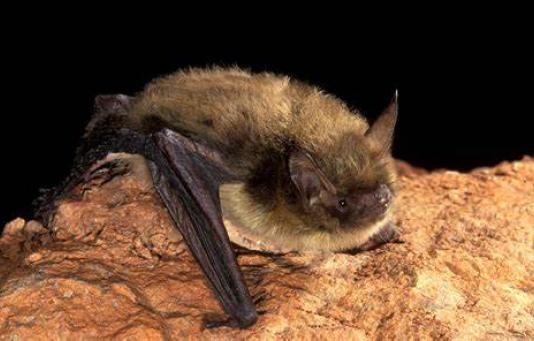Northern Long Eared Bat
The NLEB is a medium sized brown bat that hibernates during the winter and forages and roosts in upland forest habitat during the summer. The NLEB has longer ears than the other bats in the Myotis genus and eats insects like moths, flies, beetles, and caddisflies. The NLEB forage primarily through the understory of forested areas and catch insects, both while in flight using echolocation and by gleaning motionless insects from vegetation.
The NLEB and some other hibernating bat species, have experienced recent rapid population declines. The bats are dying because of a disease called White-nose Syndrome. NLEB hibernate during the winter months in small groups in caves and mines with constant temperatures, high humidity, and no air currents. White-nose Syndrome infects bats during hibernation and is caused by a fungus. Bats with White-nose Syndrome use up energy stores essential for surviving the winter, which results in strange behavior. In some cases bats have been observed to leave their hibernacula too early and perish. Scientists have found 90 to 100 percent declines in bat populations at some hibernacula in the northeast during winter surveys.
Under the federal Endangered Species Act the U.S. Fish and Wildlife Service (USFWS) has listed the northern long-eared bat as a threatened species. Threatened species are animals and plants that are likely to become endangered in the foreseeable future. The goal of the Endangered Species Act is to recover and conserve species that are in danger until the species has recovered and no longer requires the protection of the law. Though the species decline is attributed to White-nose Syndrome, now that the bat is listed as threatened, all actions that may affect the bat need to be considered and reviewed. Along with the listing the USFWS has developed a 4(d) rule.
If a proposed action will have no effect, the USFWS does not have to be notified. Projects entirely outside the range of the NLEB, or projects with no suitable habitat within the project area (high-density urban areas or non-forested areas) will result in “no effect”. Projects with No Effect include activities conducted completely within existing road/rail surface and do not involve percussive or other activities that increase noise above existing traffic/background levels (blasting and use of pile drivers, rock drills, or hoe rams), maintenance, alteration, or demolition of bridges/structures if the results of a bridge assessment indicates no signs of bats, and activities that do not involve construction, such as bridge assessments, property inspections, development of planning and technical studies, property sales, property easements, and equipment purchases. For these projects document the determination of No Effect.

Protecting Vital NLEB Habitat Areas
Consult the NH Natural Heritage Bureau and the NH Fish and Game Department to determine the proximity of known maternity roost trees and known hibernacula to the project site. These areas are essential to the NLEB at sensitive points in the bat’s life cycle and are afforded additional protection by the 4(d) Rule and the USFWS, FRA, FTA, and FHWA Range-wide Programmatic Consultation for Indiana Bat and Northern Long-Eared Bat.
For Projects with FHWA Involvement/Funding
USFWS, FRA, FTA, and FHWA have standardized their approach to assessing impacts to northern long-eared bats from highway construction and expansion projects; then avoiding, minimizing and mitigating those impacts where possible. This conference is documented in the Range-wide Programmatic Consultation for Indiana Bat and Northern Long-Eared Bat.



